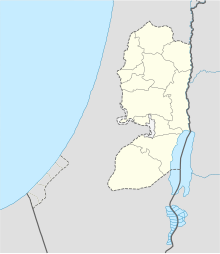Sheikh Ali al-Bakka Mosque or Shaykh Ali al-Baka Mosque (Arabic: مسجد الشيخ علي بكاء) is a 13th-century mosque in the northwestern section of the Old City of Hebron in the southern West Bank, Palestine. It is situated in the Harat ash-Sheikh (or Sheik Ali al-Bakka) quarter, one of the Old City's quarters, which is named after the mosque.[1]
| Sheikh Ali al-Bakka Mosque | |
|---|---|
مسجد الشيخ علي بكاء | |
 | |
| Religion | |
| Affiliation | Islam |
| Branch/tradition | Sunni |
| Location | |
| Location | Hebron, West Bank, Palestine |
| Geographic coordinates | 31°31′42.3″N 35°06′13.5″E / 31.528417°N 35.103750°E |
| Architecture | |
| Type | mosque |
| Style | Mamluk |
| Completed | 1282 |
| Minaret(s) | 1 |
The mosque was founded by Husam ad-Din Turuntay in 1282 during the reign of Mamluk sultan al-Mansur Qalawun. Turuntay was the representative of the sultan in Jerusalem. The sanctuary is named after Sheikh Ali al-Bakka, a renowned Sufi religious leader from Iraq who lived in Hebron.[2] The minaret was erected by the viceroy and practical strongman of the sultanate, Sayf al-Din Salar (d. 1310).[3]
The original mosque was mostly demolished,[clarification needed] however the minaret still stands and is viewed as an exemplary work of Mamluk architecture. Sitting on a rectangular base, its shaft has a hexagonal shape. The minaret base has an arched corridor which leads to the courtyard. In 1978 a new mosque was built on the site, but preserved the remains of the original mosque.[2]
References
editFurther reading
edit- Al-Maqrizi (1840). Histoire des sultans mamlouks, de l'Égypte, écrite en arabe (in French and Latin). Vol. 1, part 1. Translator: Étienne Marc Quatremère. Paris: Oriental Translation Fund of Great Britain and Ireland. (p. 242)
- Moudjir ed-dyn (1876). Sauvaire (ed.). Histoire de Jérusalem et d'Hébron depuis Abraham jusqu'à la fin du XVe siècle de J.-C. : fragments de la Chronique de Moudjir-ed-dyn. (pp. 220, 222, 224, 227, 291 ff)
- Sharon, Moshe (1999). Corpus Inscriptionum Arabicarum Palaestinae, Volume Two: -B-C. Leiden: Brill. ISBN 90-04-11083-6.
- Sharon, M. (2013). Corpus Inscriptionum Arabicarum Palaestinae, H-I. Vol. 5. BRILL. ISBN 978-90-04-25097-0. (Sharon, 2013, p. 58 ff)
- Wilson, Charles Williams, ed. (c. 1881). Picturesque Palestine, Sinai and Egypt. Vol. 3. New York: D. Appleton.
